STOLPERSTEINE GELSENKIRCHEN
Ausgrenzung erinnern

|
HERE LIVED
 ADOLF HIRSCH ADOLF HIRSCH
BORN 1869
DEPORTED 1942
THERESIENSTADT
MURDERED 23.9.1942
TREBLINKA
|
HERE LIVED
 JOHANNA HIRSCH JOHANNA HIRSCH
NEE RUBENS
BORN 1861
DEPORTED 31.7.1942
THERESIENSTADT
MURDERED 23.9.1942
TREBLINKA
|
Stumbling Stones installed at: Von-der-Recke-Straße 9
|
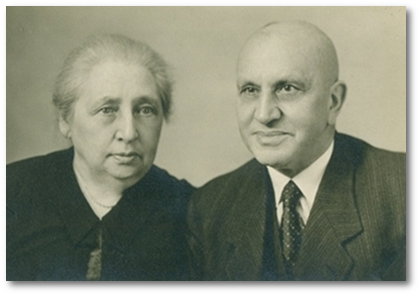
Ill.1: Adolf Hirsch and his wife Johanna, née Rubens, around 1940/41. The grandparents sent this photo as a birthday present to their granddaughter Ingrid Gunther who went on one of the kindertansports and was saved.
The businessman Adolf Hirsch was born in Lautenburg on 4 June 1869. He was married to Johanna Rubens who was born in Gelsenkirchen on 8 November 1861. The couple had one child, a son called Ludwig who was born in Gelsenkirchen on 31 October 1899.
Adolf Hirch’s company was already located at Von-Der-Recke Strasse 4 in Gelsenkirchen before World War One. In 1920 Adolf Hirsch bought the house at Von-Der-Recke Strasse 9 which had been built a few years before. The Hirsch family lived on the ground floor and at the back of the house they ran the “Adolf Hirsch Wachstuche Grosshandlung GmbH”, a wax cloth wholesale company. Ingrid Gunther, one of Ludwig Hirsch’s daughters, remembers that 5-10 people were employed there. And her father, who in 1921 had already moved from Recklinghausen South, continued to work at her grandfather’s firm in the old town of Gelsenkirchen.

Ill. 2: Adolf Hirsch’s company in the Gelsenkirchen address book, 1914/15 edition
Up to now nothing is known either about the economic development of Adolf Hirsch’s company after the transfer of power to the Nazis in January 1933 nor about what happened to the couple’s property. It can certainly be assumed that Adolf Hirsch and his wife also suffered the discrimination, sanctions and confiscations ordered by the Nazis against German Jews.
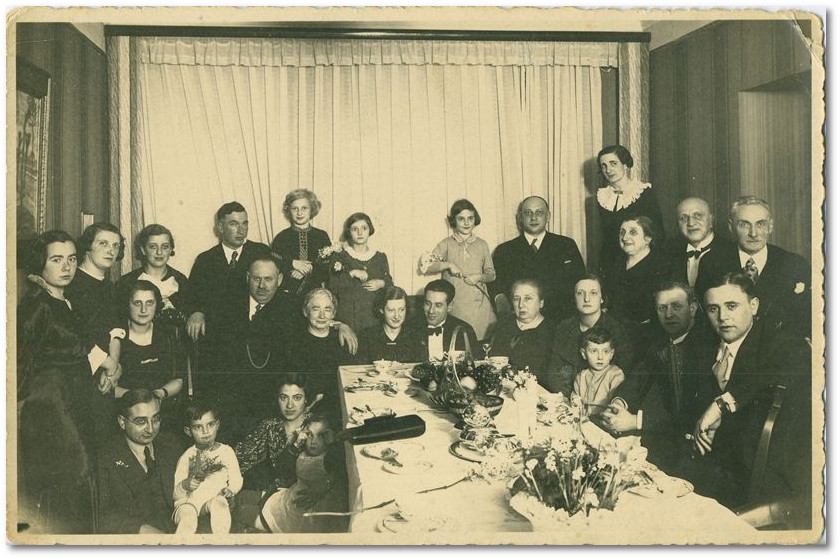
Ill. 3: Hirsch family 1935; the photo was taken at the engagement party of Ingrid Gunther’s aunt and her fiancé
The records of the Gelsenkirchen Registration Office clearly show that on 18 March 1942 Adolf and Johanna Hirsch had to move from their house at Von-Der-Recke-Strasse 9 to one of the so-called “Jewish Houses” in Gelsenkirchen at Kloster Strasse 21. On 31 July 1942 Adolf and Johanna Hirsch were deported to the Theresienstadt Ghetto. From Theresienstadt they were both moved to the Treblinka Extermination Camp where they were murdered on 23 September 1942. Ludwig Hirsch was able to leave Nazi Germany with his wife Bertha, née Heinberg, and their two daughters Ingrid and Ruth in August 1939.
|
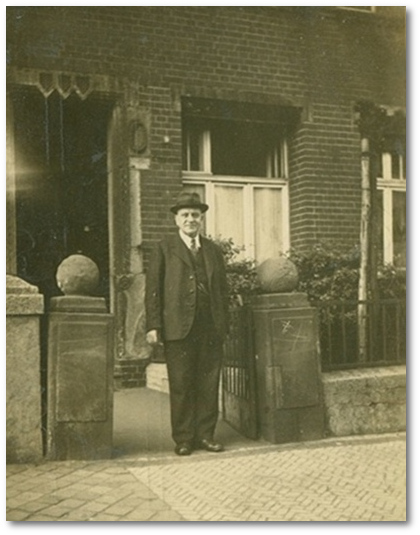
|
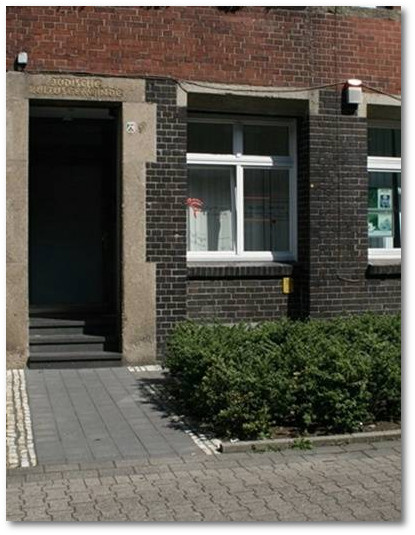
|
Ill. 4 u. 5: Adolf Hirsch outside his house at Von-Der-Recke-Strasse 9; photo on the right shows the entrance area of the house in July 2013. Right there the stones will be installed by sculptor Gunter Demnig in this year.
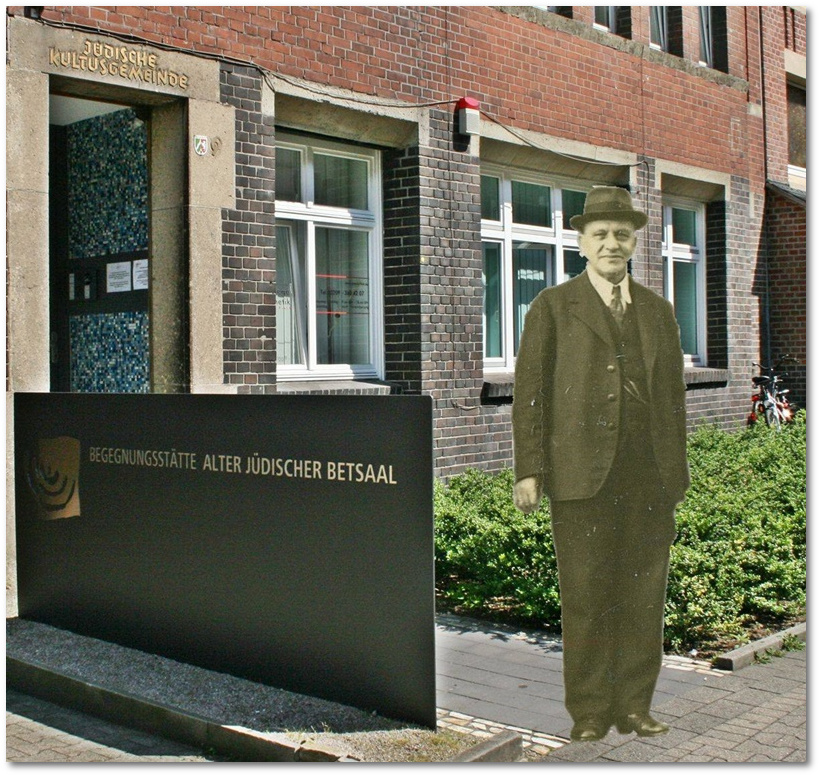
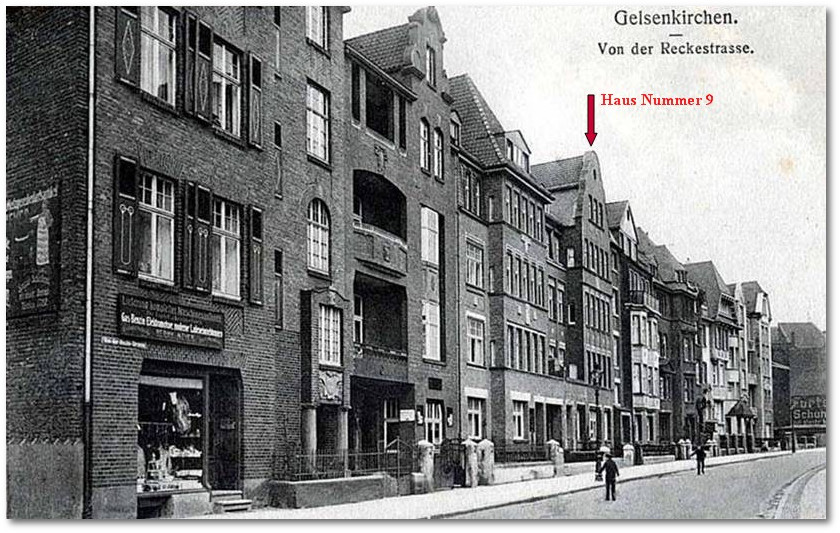
Ill. 6: Die Von-Der-Recke-Straße um 1915
After World War Two, as part of the so-called “reparations”, Ludwig Hirsch (Leslie Hilton) became the owner of the house he inherited from his parents at Von-Der-Recke-Strasse 9. He sold the house. From 1957 the Jewish Community of Gelsenkirchen used the building where until 2007 they had a prayer room and a community centre. Today the building houses, among other things, the “Begegnungsstätte Alter Betsaal” (the Old Prayer Hall Meeting Centre).
Ingrid Gunther and Ruth Haas, the granddaughters of Adolf and Johanna Hirsch, are the sponsors of the stumbling stones soon to be installed in the sidewalk in memory of Adolf and Johanna Hirsch.
References:
ITS Archive, Arolsen:
Doc. No. 5174729#1 (1.1.47.1/0001-0181/0149/0046), Listenmaterial verschiedene Lager
Doc. No. 12852533#1 (1.2.5.1/REES-ZWEIBRÜCKEN/SK GELSENKIRCHEN/0082), Gemeindelisten über jüdische Residenten / SK Gelsenkirchen
Doc. No. 5046922#1 (1.1.42.2/THERES40/1905) u. No. 5046474#1 (1.1.42.2/THERES40/1456) Kartei Theresienstadt
Address book Gelsenkirchen, 1934 edition,
Electoral list of 15 November 1930 for the foundation of the liberal Jewish Synagogue Community, StA GE 0 XXII 10 1
Memorial book, German federal Archives
Lists of the Jewish Community regarding deportations in: Andrea Niewerth, Gelsenkirchener Juden im NS, 2002
Registration records, StA Gelsenkirchen/ISG
registration records, StA Recklinghausen
www.holocaust.cz (Abruf Juli 2013)
Ill.1, 3, 4: Private property of the family, with courtesy of Ingrid Gunther
Ill.2: Address book, 1914/15 edition. Courtesy of Volker Bruckmann
Ill.5: Gelsenzentrum e.V.
Ill.6: Collection Karlheinz Weichelt, with kind permission.
Projektgruppe STOLPERSTEINE Gelsenkirchen. July 2013
|
Stumbling Stones in memory of Adolf und Johanna Hirsch, installed December 17, 2013 in Gelsenkirchen
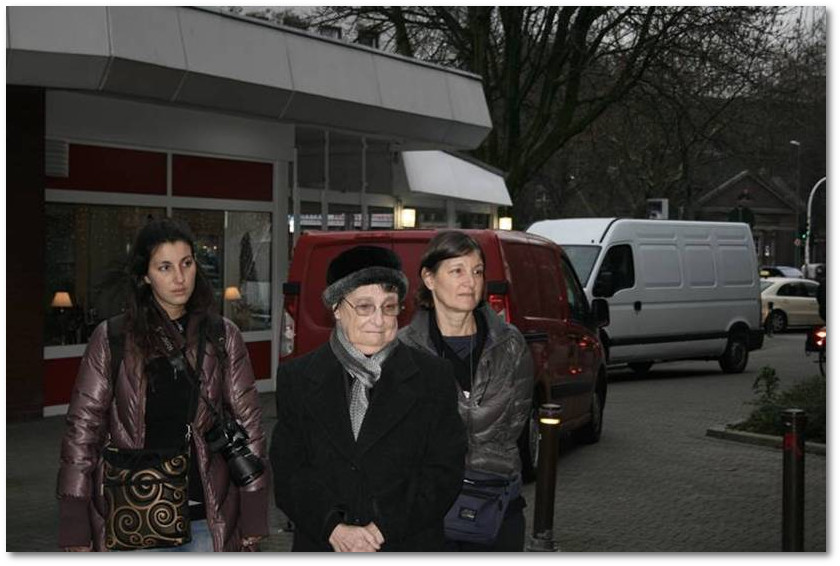
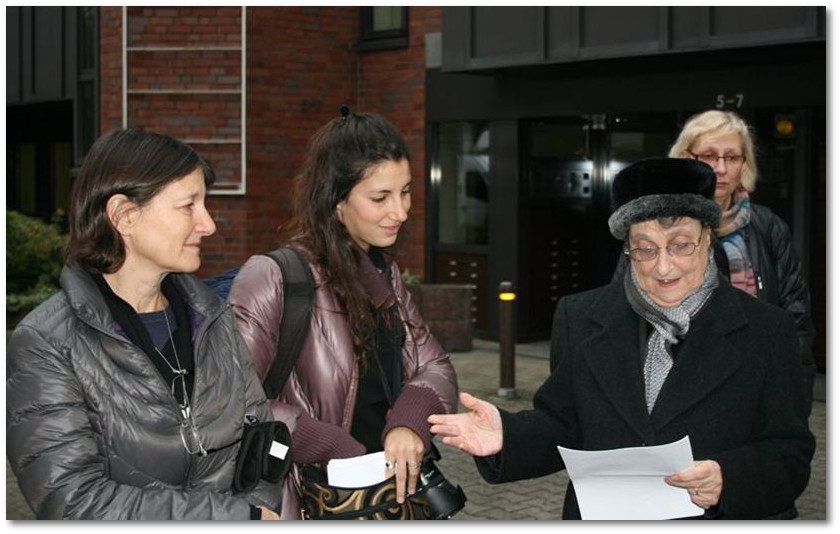
Speech by Ingrid Gunther in Gelsenkirchen, Von-Der-Recke-Straße 9, December 17, 2013:
"I am very grateful to be here and for that I must thank my daughters. Claudia for flying from Los Angeles to Washington DC to stay with my husband and Nina and my granddaughter Dafna for coming from Tel Aviv to be here with me. Without their help I could not have made the trip.
It is a very strange sensation to be standing here in front of my grandparents’ house remembering events that happened 80 years ago. It is amazing how clear the recollections are. We lived in Recklinghausen which I had always assumed was quite far away since we had to take a streetcar and train to get here. We came many times and on two occasions I stayed for several weeks. I even went to school here for a few weeks.
My grandparents had a small factory employing about ten people They manufactured pillows, eiderdowns and tea cosies an item now extinct but very much in use then. They were very orthodox and one of my fondest memories is of the observance of the Sabbath. The calm that descended on the house after the candles were lit was magical. I must admit that my grandfather was not quite as observant as my grandmother. Towards the end of the Sabbath my grandfather became increasingly impatient to open the mail and turn on the radio to connect with the world again.
My grandparents were much beloved, not only in the Jewish community but by all their neighbors. Perhaps the best proof of that is that before the madness of kristalnacht they received a phone call telling them to hide in the attic and even though their apartment was broken into, nothing was disturbed. November 8 was my grandmother’s birthday and we had all gathered for the celebration. My sister Ruth stayed while the rest of us went home. She distinctly remembers that nothing in the apartment was touched, and in her words “not even the paper used for wrapping gifts was disturbed”. Another of my sister’s memories is of walking with my grandfather in the Stadtpark and sitting on a bench which was no longer permitted for Jews and being told by my grandfather “don’t tell your grandmother”.
This commemoration is also for my father who grew up in this house. In fact there was a tree in the back yard which he had planted as a child. After my father’s marriage he continued to work here with his parents. My father never knew the exact manner of his parents’ death or when and thus he was never able to light a jahrzeit candle for them He was the much beloved only son and, my sister and I were the much adored grandchildren. My grandparents had a profound influence on my life and I have always treasured their memory.
I want to express my thanks to Andreas Jordan for all his help in arranging this occasion. After countless emails I feel as if I have a new friend. I am grateful to Gunter Demnig for the brilliant idea of the stolpersteine and for seeing to their installation. To all who came to participate let me say thank you. You have made this occasion memorable.
|
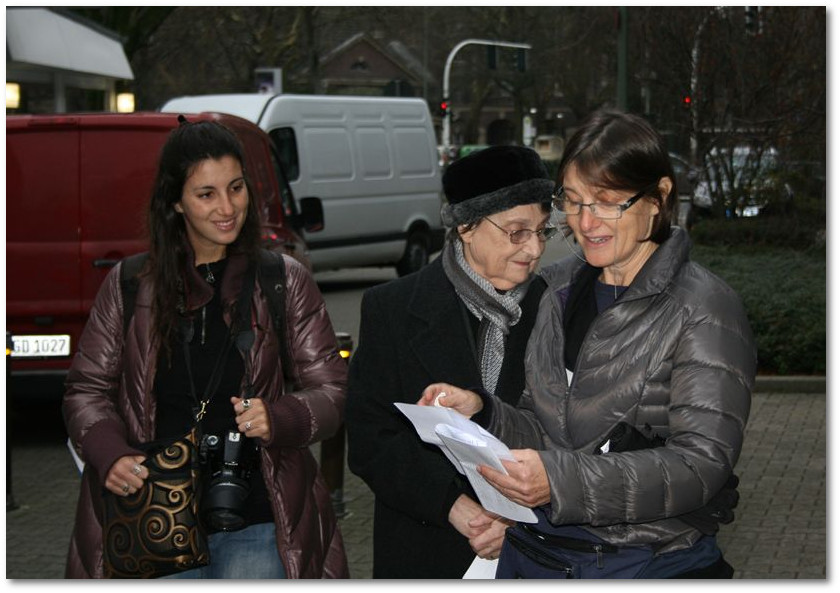
Speech by Nina Hassin in Gelsenkirchen, Von-Der-Recke-Straße 9, December 17, 2013:
"We are standing here, my mother, Ingrid Gunther, born in Essen Germany, grew up in Recklinghausen and left for England on a Kindertransport train when she was 10. After the war, along with her parents and her sister, she moved to the United States. Myself, Nina Hassin, born in the United States and moved with my parents and sister to Israel. And Dafna Hassin, my daughter, born and lives in Israel.
Three generations standing here amongst you to commemorate my great grandparents, Johanna and Adolf Abraham Hirsch. We are representing our whole family at this ceremony. My sister, Claudia Buchinsky, and her children Adie and Sivan Buchinsky, my son Yoel Hassin, my mother's older sister, Ruth Haas, her children, Debbie Seaward and Bob Haas, and her grandchildren David and Rachel Seaward are a part of this ceremony and are sharing this experience with us.
In the past few days I have heard many stories about my mother's past. For the first time I have heard my mother's loving memories of her grandparents. On our way over here she mentioned that maybe the tree in the park across from here is still standing. She used to hide behind the tree again and again and each time her grandfather was so surprised to "find" her!
When I think about the Stolpersteine project there are two words that come to my mind: "Courage" and "Humanity". It is necessary to look the painful atrocious past in the eye, but it takes courage to initiate an action that distributes reminders throughout the cities. These reminders have become a part of the daily life here. This project is also an expression of humanity that has developed out of the dark past, and this group of strangers, who stopped their daily routine of life in order to commemorate a member of their community, who happens to be a part of our family, is an example.
My mother was uprooted from her home and family at the age of 10. She has never had the feeling of "belonging" since then. Not in England, nor in the US where she has lived for most of her life, nor in Israel because of the very short time she lived there. She rarely shared her German childhood with us. This was because the early, happy childhood was buried. Now with the stolpersteine before her grandparent's house and with this ceremony, we have a feeling that there is a legitimacy to recall the time when our family was a part of the community. Also for the people who walk by, there is a remembrance that there was a family who was once a part of them.
I am amazed at the impact the Stolpersteine Project has had on my family. On behalf of our family we thank you for the opportunity to be here with you and truly admire your noble undertaking."
|
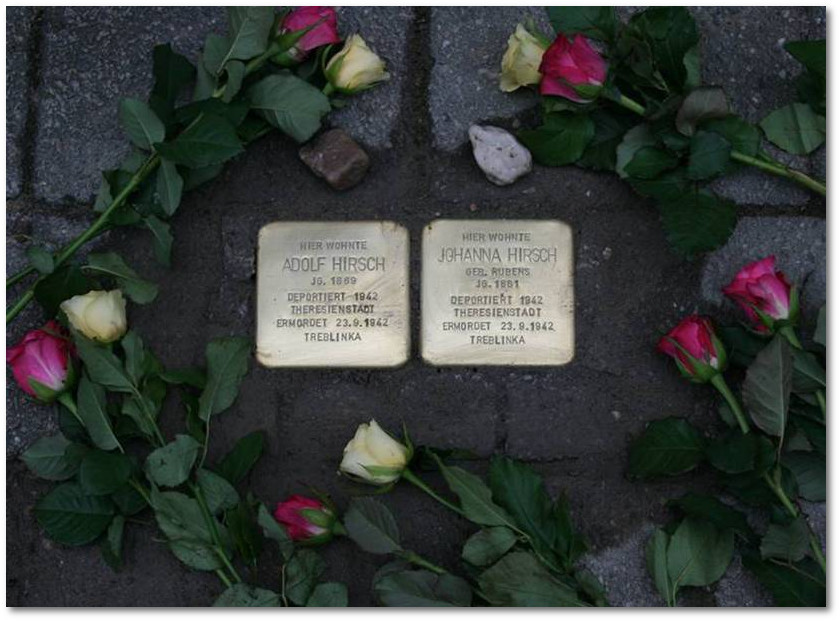
Projektgruppe STOLPERSTEINE Gelsenkirchen. Dezember 2013
|
↑ Up
|
|